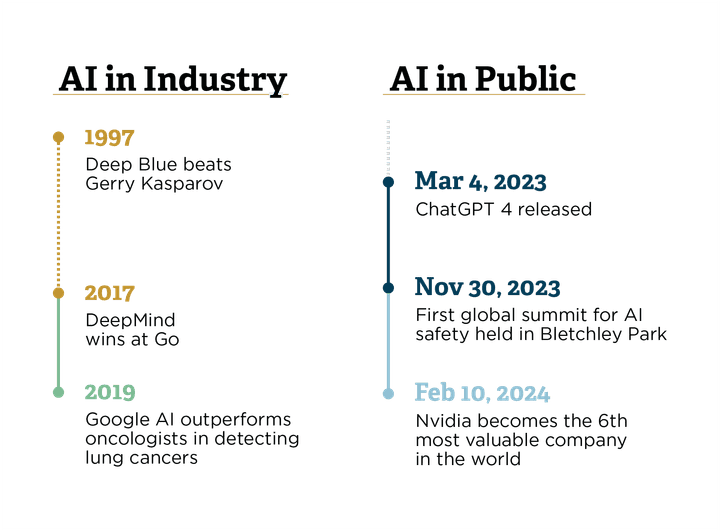With the AI market projected to reach $305 billion by 2024, it's no surprise that businesses across all industries are exploring ways to leverage the technology to gain a competitive edge. However, the rise of AI has also presented unique challenges and opportunities for change leaders tasked with navigating the complex interplay between technological innovation and human adaptation.
With so much hype surrounding the impacts of AI, change leaders need to understand AI fundamentals, its impact on how we work, and how to prepare their people for this new AI-driven landscape.
Related Content: AI in Action: How Top Businesses Shape Their AI Strategy
# What is AI?
In its simplest form, artificial intelligence is a field of study that combines computer science and robust datasets to enable problem-solving. AI encompasses various mathematical and scientific fields, including deep learning, machine learning, and statistical modeling. These disciplines are brought to bear when building AI algorithms that seek to create expert systems that make predictions or classifications based on input data. However, AI is not as other-worldly as it seems; in fact, AI should feel familiar to most of us. AI appears in many recognizable ways, from Netflix movie recommendations to Apple’s voice assistant Siri to recommended accounts on Instagram.
# What Isn’t AI?
- AI is not magic. While AI can do amazing things when implemented correctly, it is not a solution to all an organization’s problems. For an AI to get intelligible, consistent results, it requires defined inputs and a defined goal to train towards.
- Ai is not a monolith. There are multiple AIs on the market right now, and not all are built the same. ChatGPT is currently the most well-known AI, but there are thousands of AIs worldwide built from different foundational models and data sets.
- AI is not a person. Humans have a natural inclination to project human qualities onto non-human entities. But AI is not a person. It does not reason like a person and cannot generate human empathy or connections.
# The History of AI: From the Tech Sector to Public Consumption
For the last 20 years, AI has been a source of serious investment and research and development in the tech sector. Larger consulting and investment firms have also poured resources into understanding and tracking its development.
Comparatively, AI has had a much different lifecycle in the public eye. With the release of ChatGPT in early 2023, interest in Generative AI specifically and the impact of AI on business and culture has reached a fever pitch in the public domain. This has created a hype cycle around AI.

# The Impact of AI on Change Management
According to Forbes, AI will impact some industries, such as finance, media, and legal services, more heavily than others. While change managers may not lose their jobs to AI, they will be impacted, and preparing for these impacts is critical.
We expect the impact of AI on change management to be two-fold:
#
# 1 | Shift in the Types of Change Projects
AI is already causing a shift in the types of projects and support requests that change managers receive. We expect to see an increase in demand in the following projects:
- Technology Implementation: AI implementation requests and projects are increasing and will require change managers to understand the basics of technology implementation projects, but with an added layer of empathy for tech partners. AI implementation projects are also new to these stakeholder groups, so normal waterfall or agile approaches will need to shift.
- Organizational Design: AI is already shaking up how companies are structured to create more efficiency or open new functions to enable AI. Some organizations are creating new Chief AI Officer roles. Incorporating AI into organizations will require new organizational structures, teams, and work that didn’t exist before.
- Job Upskilling and Reskilling: Perhaps your company isn’t doing a full organizational redesign, but the chances are that AI will take over certain aspects of people’s roles. Change leaders should be prepared to help people embrace their roles in this new future state through upskilling and reskilling.
- Resistance Management: As with any big change, there will be resistance. However, AI presents an added layer of fear, creating more resistance than previous tech implementations. You need to be prepared to lead people and their leaders through this resistance by clearly articulating the future state.
- Culture Transformations: AI is more than just a technology; it changes how we interact with tech. Therefore, an organization’s culture will see shifts, and you must be prepared to discuss it. The rate of change with AI is unlike anything we have ever seen, and you need to create a culture ready to embrace it.
# 2 | Opportunities for Change Managers to Incorporate AI
Change leaders need to manage AI-influenced change and lead by example. You have the unique opportunity to lead the change and incorporate AI, particularly generative AI, into your workflow. This doesn’t mean using ChatGPT to complete your next stakeholder assessment, but it does mean you can utilize the resource to help draft executive communication.
Areas AI Can Support Change Management Work:
- Communication and Documentation
- Training Design and Build
- Compliance and Risk Assessment
- Survey and Feedback Analysis
- Persona Mapping
- End User Support Chatbots
All this is to say that while change manager roles aren’t disappearing, they are being impacted by the public arrival of AI. As a result, change leaders need to take on new responsibilities.
# How to Prepare Your People for AI in Business with Change Management Best Practices
Change leaders must prepare for the transformative change that is AI on both the business and the people. The same tried and true change management tactics still work here. In many ways, this is similar to the push for cloud technology over the last 15 years. Concentrate on the tactics you have used before, but make sure you are emphasizing the right things:
- Build the Case for Change. You will need clear benefits statements, as well as the purpose and goals of AI at your organization and how it helps the individual. Remember, it is also about looking ahead and how leveraging AI brings us into the future as an organization.
- Understand the Impacts of AI. Take the time to truly understand the scope and breadth of changes AI will have on your organization. Is this just a tech implementation, or is this going to cause an organizational redesign work down the road?
- Communicate Relentlessly. Be authentic with communication by addressing known challenges openly and not overselling the benefits. Seek to find ways to communicate the AI vision broadly while leveraging creative elements in how you talk about AI, or better yet, use AI to help uplevel your communications.
- Establish Governance. AI is changing how organizations approach and incorporate technology. This means building a strong relationship with your technology teams is critical. Setting up strong governance structures will enable open communication across teams. This will help you be prepared to understand the change impacts and advocate for the people side of change.
- Provide Education and Training. This could be a standard training rollout like you would for any new tech implementation, or this could mean up-leveling and reskilling people for changes in job roles. To answer that you need to understand how AI will impact your technology infrastructures.
- Address Concerns Head On. We can guarantee there will be some level of resistance to AI on your teams. Once you understand that, you can proactively create resistance management plans, set up feedback loops early, and lean on your governance and sponsorship structures to help you mitigate resistance.
#
# This is more than a technology change, though.
While all the above is true, it is also important to point out that AI is very different from cloud migration projects many have experience with. This change differs because AI represents a mindset shift and requires targeted intervention. Job aids, newsletters, and a change network alone will not be enough. You must treat this as a transformative cultural change. It’s about shifting the mindset of how people think about and interact with technology.
Related Content: The Interrelation Between Change Management and Culture Change


# Have a Culture Plan: How To Start Shifting Mindsets to Support AI Initiatives
- Culture is not a standalone initiative. Transformation is significantly complex, and there will be substantial interdependencies between technical and people changes. Culture is equally as important as other business drivers, and as a change leader, you need to speak up for those culture transformation objectives.
- Consider the full landscape. Make clear that the status quo is more dangerous than adopting AI. Think holistically about changes your people face, including those outside AI work. Monitor and manage change saturation across the board.
- Ensure leaders are visibly on board. Cultural change starts with strong leadership. They must seek to understand, support, and communicate the vision behind AI and model this new technology-driven culture.
- Strike while the iron is hot. Make the most of this rare opportunity to change your organization's perspective and attitude towards AI now while it is a top news story.
# The Future of AI: Reshaping Change Leadership
As change leaders, we must embrace AI as both a technology and a mindset change. By understanding AI and its potential applications, we can incorporate it into our work and empower our teams to drive positive change and better outcomes. With the right approach, AI can be a powerful ally in our efforts to navigate the evolving landscape of business and technology.
At Propeller, our people and change management experts provide tools, resources, and thought leadership to help organizations tackle today’s challenges with strategic, long-term people and change solutions. Whether it’s an organizational re-alignment, a tech implementation, or new talent development strategies, our experts can help you successfully lead change in your organization. Reach out today.





